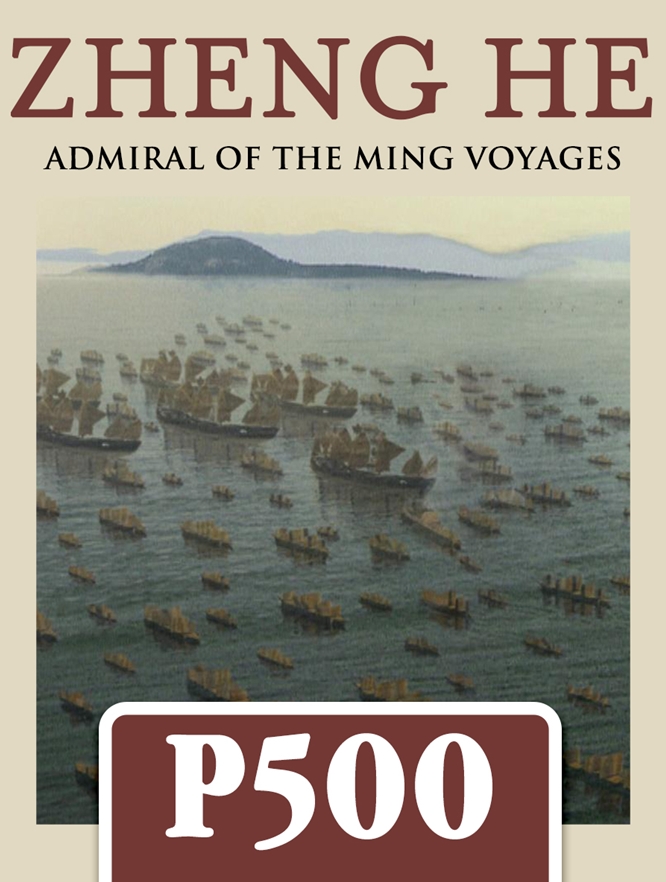Zheng He (1371 – 1433) was a Chinese admiral who commanded seven expeditionary voyages during China’s early Ming Dynasty. Between 1405 and 1433, the Ming government launched the expeditions to expand China’s presence, influence trade, impress foreign governments, and extend the empire’s tributary system throughout the Indian Ocean.
The voyages were astonishing, both in size and scope: during the early voyages, Zheng He travelled from China to Southeast Asia and then on to India’s southwest coast. In the fourth voyage, the fleet traveled to the Persian Gulf. And on the three last voyages, the fleet traveled even further, all the way to the east coast of Africa. While this was impressive, Chinese merchants had traveled this far before. What was unprecedented was that the voyages consisted of hundreds of huge ships and tens of thousands of sailors and other passengers. Over sixty of the more than three hundred ships on the first voyage were enormous “Treasure Ships,” sailing vessels over 400 hundred feet long, 160 feet wide, with several stories, nine masts and twelve sails. The likes of these ships had never before been seen in the world, and it would not be until World War I that such an armada would be assembled again.

Zheng He generally sought to attain his goals through diplomacy, and his large fleet and army awed most would-be enemies into submission. However, Zheng He did not shrink from force when necessary. During the voyages, he battled pirates that had long plagued Chinese and Southeast Asian waters. He also waged a land war against the Kingdom of Kotte on Ceylon, and made displays of military force when local officials threatened his fleet in the Middle East and East Africa. Over the course of the voyages, envoys from over 30 states traveled to China and paid their respects at the Ming court.
In spite of the successes of the voyages, they remained a continuous point of contention between the Emperor and his court, most of whom believed them to be a waste of resources. With the Emperor’s death, the voyages quickly ceased, and China withdrew from the seas just before the arrival of the Europeans.
Gameplay
Zheng He: Admiral of the Ming Voyages is a solitaire game that recreates the voyages of the Ming treasure fleets in the early 1400s. In the game you take the role of Zheng He, commanding the fleet as it sails the Indian Ocean, earning glory for the emperor, and keeping favor with the ministers of the court so the voyages can continue. Your goal is to score as many Victory Points as possible until the political will to continue the voyages runs out. Victory Points are earned by visiting ports, gaining envoys, winning battles, and completing special goals. You also earn Minister Points during each voyage by trading and having good relations with ports, which determine whether the game continues with another voyage, and also allow you to upgrade and repair the fleet, and recruit and train officers.

Game Mechanics
Zheng He is played over a series of voyages, called a campaign. Each voyage consists of three phases: Preparation, Voyage, and Aftermath. In the Preparation phase, you determine the goal for the voyage and set up your fleet. The Voyage phase is the bulk of the game, wherein your fleet travels across the map, performing actions to earn Victory Points and Minister Points. In the Aftermath phase, Minister Points are calculated and you check to make sure you have enough support from the ministers to continue to your next voyage. You also spend Minister Points to upgrade your fleet. Victory Points determine how favorably the emperor views your voyage.

Most of the board is taken up with a map of the Indian and Pacific Ocean regions where your fleet will travel. It is broken up into 18 ports, represented by circles (plus Nanjing, where you start). Each port is associated with a corresponding port card. When you travel to or scout a port, you place Encounter and Leader cards on the Port card. These cards determine the events that can take place at the ports and adjust your relations with the port.

At the beginning of each of the voyage’s 22 turns, you draw a token from a bag, representing the omens from Tianfei, the Chinese goddess who offered protection to sailors. These Tianfei tokens establish the overall level of difficulty for the turn. Some of the tokens have just a single number for difficulty, some require you to roll a die to add uncertainty to the difficulty, and some feature three different numbers so that difficulty is determined by your current relations in the port where your fleet is located.

You command your fleet through the use of a deck of fleet cards. At the start of the first voyage, you have a deck of 20 cards that represent the ships in your fleet, including treasure ships, patrol ships, supply ships, equine ships, and troop ships. On your turn, you will play these fleet cards to take a wide variety of actions that allow you to sail, build bases, improve relations, battle, resupply, repair the ships in your fleet, and more.
By managing your fleet effectively through the use of your fleet cards, combined with special leaders that you can add over the course of the campaign, you can accomplish special goals, win battles against pirates, take on envoys, build bases, trade goods and more. Through these accomplishments, you will gain Victory Points to earn the emperor’s favor and garner enough Minster Points to appease the ministers and earn the chance to attempt another voyage.
Players: 1
Age: 14+
Playing Time: 30 minutes (per voyage); full campaign can be played in approximately 5 hours
Components
- 11″x17″ game board
- 70 Poker-size cards
- 90 Mini Euro-size cards
- 2x Wooden Fleet Meeples
- 1 Punchboard Fleet divider
- 36 Punchboard tokens
- Voyage Log Pad
- 3 custom dice
- Rules/Playbook
- Plastic bags


Comentarios